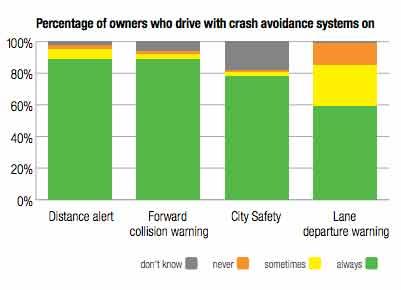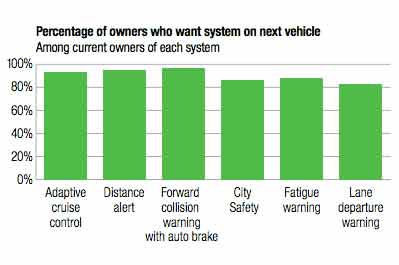
IIHS is evaluating City Safety and other crash avoidance systems at its Vehicle Research Center. HLDI analysis of claims for Volvos with City Safety indicates the system is reducing crashes. Volvo owners say they like the features.
Owners of Volvos with advanced crash avoidance features find the systems useful, and the vast majority would want the technology again, an IIHS survey shows. The positive results are in line with an earlier survey (see Status Report, Nov. 18, 2009, at iihs.org). This time, the participants were not limited to the early adopters questioned several years ago, when the technology was new.
Researchers interviewed nearly 500 owners of Volvo models with crash avoidance features. Some had City Safety, a low-speed forward collision avoidance system standard on certain models; some had an optional technology package that includes forward collision warning, lane departure warning and other features; and some had both.
“The majority of these drivers told us they like the crash avoidance technology in their vehicles,” says Anne McCartt, senior vice president for research at IIHS. “For the most part they are taking advantage of the systems, and many credit them with preventing crashes.”
Based on insurance data, these systems appear to be reducing crashes. The Highway Loss Data Institute (HLDI) has found that the rate of property damage liability claims for Volvos with standard City Safety is lower than for other vehicles in the same class and for Volvos without the technology (see Status Report, July 19, 2011). HLDI also found lower claim frequencies with the optional technology package, which includes a higher-speed forward collision warning system with autonomous braking, adaptive cruise control, distance alert, lane departure warning and fatigue warning (see Status Report, July 3, 2012).
Drivers’ reactions are important because many systems provide only warnings and require drivers to take action. And most features can be deactivated, so the technologies need to be accepted to be effective.
Among the respondents with the optional technology package, about half said they always used adaptive cruise control, which maintains a set following distance, on high-speed roads. Eighty-nine percent said that when adaptive cruise control is not in use they always drive with distance alert, which warns the driver if the vehicle is getting too close to one in front but, unlike adaptive cruise control, doesn’t affect vehicle speed. The same number said they leave forward collision warning on at all times, while fewer than two-thirds always drive with lane departure warning. Of the respondents with City Safety, 78 percent always drive with the system on. Eighteen percent said they weren’t aware they had City Safety. It is likely those people also were driving with the system activated, since the default is “on.”
The lower use rate for lane departure warning may be related to the annoyance factor: One-third of respondents said they found the feature’s warning chime annoying. Drifting slightly over a lane marking is a common occurrence, and some drivers are accustomed to exiting, merging or changing lanes without signaling, which would trigger the warning. The system also can be triggered by things like old lane markings in construction zones.
The earlier IIHS survey, which involved owners of Volvo and Infiniti vehicles with crash avoidance features, also found that fewer drivers kept lane departure warning on at all times than other features. In that survey, a quarter of Volvo owners and 41 percent of Infiniti owners found lane departure warning annoying. The tendency to turn off the system seems to have grown: Among the first group, 69 percent of Volvo owners said they always drove with lane departure warning, compared with 59 percent in the new survey.
In the current study, most owners reported experiencing activations of lane departure warning, forward collision warning and fatigue warning. Thirty-seven percent said they experienced autonomous braking, including City Safety. Many respondents said they believed the features had helped prevent crashes. For example, 45 percent of those who had driven with forward collision warning said the alerts from that feature had helped them avoid a crash.
Warnings perceived as false or unnecessary were reported by 37 percent of owners for forward collision warning and 33 percent for lane departure warning. Unnecessary autonomous braking wasn’t as commonly reported at 14 percent.
For each feature, more than 80 percent of respondents said they would want the system again on their next vehicle. While the responses are similar to the earlier survey, this update shows positive reactions weren’t limited to drivers who eagerly snapped up a brand new safety technology. The first survey involved Volvos from 2008, the first model year that both forward collision warning and lane departure warning were offered as options. The current study involves 2010-12 Volvos and is the first to look at City Safety, which, because it comes standard, could be more likely to include respondents whose attitude toward safety is similar to the average driver.



